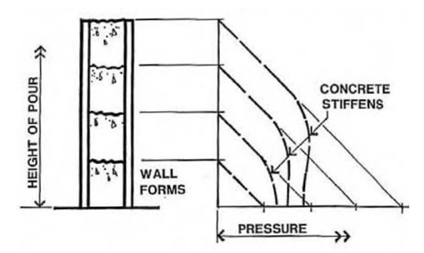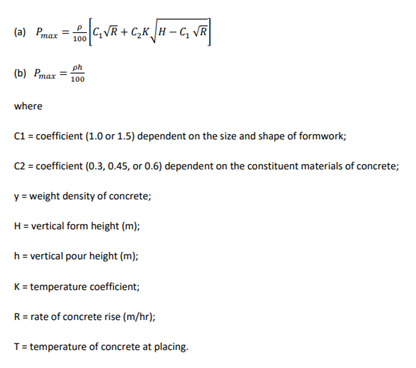Concrete Pressure
Concrete Pressure is the force of the concrete applied to the face of the formwork. Typically, it is resisted by thru-ties on double sided formwork or with diagonal props on single sided formwork. Determining concrete lateral pressures is detailed in AS3610 and is based on a range of factors detailed below.
- Rate of placing concrete in forms
- Temperature of the concrete
- Weight or density of the concrete
- Cement type or blend used in the concrete
- Method of consolidating the concrete
- Method of placement of the concrete
- Depth of placement
WHAT IS CONCRETE?
Concrete is a mixture of sand and aggregate that is bonded together by cement and water. Admixtures are commonly used in concrete mixes and include liquids, solids, powders, or chemicals that are added to a concrete mix to change the basic properties. They can accelerate or retard setting times, decrease water permeability, or increase strength, air content, and workability. Admixtures include things such as silica flume, blast-furnace slag, and fly ash.
CONCRETE PLACEMENT
Concrete behaves temporarily like a fluid, producing a hydrostatic pressure that acts laterally on the vertical forms. This lateral pressure is comparable to full liquid head when concrete is placed full height within the period required for the concrete to initially set.
With a slower rate of placing, concrete at the bottom of the form begins to harden and lateral pressure is reduced to less than full fluid pressure by the time concreting is completed in the upper parts of the form. The effective lateral pressure is influenced by the weight, rate of placement, temperature of concrete mix, use of retardant admixtures, and vibration.
As this relaxation in pressure is related to the time for the initial set of the concrete to occur, it follows that the faster the concrete is poured the less the pressure will relax.
As can be seen from the below image, the linear diagonal lines denote the full hydrostatic pressure, and the dashed lines denote the setting affect of the concrete if the rate of rise is reduced.

CONCRETE PRESSURE EQUATION
The concrete pressure is determined using the below equation:

FACTS ABOUT CONCRETE PRESSURE
Wall thickness effects concrete pressure
Incorrect, wall thickness has no direct effect on the lateral concrete pressure. The wall can be 200mm or 800mm wide and the pressure will remain the same.
Concrete weights vary in different areas of Australia
Correct, due to the different weight of the rock used in the mix the weight of the concrete per cubic meter can vary. Concrete is typically between 2300 and 2700 kilograms per cubic meter.
I can used self-compacting concrete with the above pressure equation
Incorrect, if using self-compacting concrete, you must take the pour as fully hydrostatic and not allow for any setting effects.
Concrete Temperature
The temperature noted in the pressure calculation is the concrete temperature at point of discharge. If you do not know this value, AS3610 states, you must use the 9am mean temperature for that location.
THINGS TO LOOK FOR WHEN DETERMINING CONCRETE PRESSURE
Will external vibrators be used?
If external vibrators are to be used on the formwork, care must be taken not to vibrate below the area of hydrostatic concrete. Consult and engineer and ask for a vibration plan.
Retarders
Will there be excessive retarders added to the mix? We are now experiencing mixes that take 10+hrs to reach initial set so care needs to be taken as this will mean the pour remains fully hydrostatic.
Excessive Fly Ash or Slag added to the mix
If there is excessive fly ash or slag in the mix the C2 factors will increase and needs to be considered in the pressure calculation.
Please note that this advice and the comments herein are general in nature. If ever in doubt, please seek advice from an engineer.
